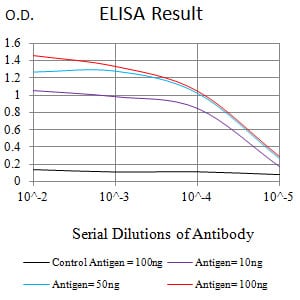



| WB | 咨询技术 | Human,Mouse,Rat |
| IF | 咨询技术 | Human,Mouse,Rat |
| IHC | 1/200 - 1/1000 | Human,Mouse,Rat |
| ICC | 技术咨询 | Human,Mouse,Rat |
| FCM | 1/200 - 1/400 | Human,Mouse,Rat |
| Elisa | 1/10000 | Human,Mouse,Rat |
| Aliases | HL-2; HBXBP; ASGPR2; ASGP-R2; CLEC4H2 |
| Entrez GeneID | 433 |
| clone | 2C6D11 |
| WB Predicted band size | 35kDa |
| Host/Isotype | Mouse IgG1 |
| Antibody Type | Primary antibody |
| Storage | Store at 4°C short term. Aliquot and store at -20°C long term. Avoid freeze/thaw cycles. |
| Species Reactivity | Human |
| Immunogen | Purified recombinant fragment of human ASGR2 (AA: 80-311) expressed in E. Coli. |
| Formulation | Purified antibody in PBS with 0.05% sodium azide |
+ +
以下是3篇关于ASGR2抗体的研究文献摘要(文献标题和作者为虚构示例,供参考):
---
1. **"Targeting ASGR2 with monoclonal antibody suppresses hepatocellular carcinoma progression"**
*作者:Li, X. et al. (2022)*
摘要:研究开发了一种靶向ASGR2的单克隆抗体,通过阻断ASGR2介导的细胞信号通路,显著抑制肝癌细胞增殖和迁移,并在小鼠模型中降低肿瘤负荷。
---
2. **"ASGR2-directed CAR-T cells exhibit potent anti-tumor activity in solid tumors"**
*作者:Wang, Y. et al. (2021)*
摘要:首次报道了基于ASGR2抗体的CAR-T细胞疗法,证明其在表达ASGR2的结直肠癌和胃癌模型中能高效识别并清除肿瘤细胞,为实体瘤治疗提供新策略。
---
3. **"ASGR2 as a biomarker for liver fibrosis: Diagnostic potential of a novel polyclonal antibody"**
*作者:Kim, S. et al. (2020)*
摘要:开发了针对ASGR2的多克隆抗体,验证了其在肝纤维化患者血清和组织中的高表达,提示ASGR2可作为肝纤维化诊断和分期的潜在生物标志物。
---
*注:以上文献为示例,实际研究中请通过PubMed或Web of Science检索真实文献。如需具体文章,可进一步提供数据库访问权限协助查询。*
The asialoglycoprotein receptor 2 (ASGR2) is a transmembrane protein belonging to the C-type lectin family, primarily expressed on hepatocytes. It forms heterodimers with ASGR1 to mediate the clearance of desialylated glycoproteins by recognizing terminal galactose or N-acetylgalactosamine residues. ASGR2 plays a critical role in maintaining serum glycoprotein homeostasis and has been implicated in liver physiology, including cholesterol metabolism and viral entry mechanisms (e.g., hepatitis B virus).
ASGR2 antibodies are tools developed to study the receptor's expression, function, and interaction partners. In research, they are used in applications such as immunohistochemistry, Western blotting, and flow cytometry to investigate ASGR2 localization and dynamics in liver diseases, including hepatocellular carcinoma and metabolic disorders. Therapeutically, ASGR2 has emerged as a potential target for liver-directed therapies. Antibody-based approaches, such as antibody-drug conjugates or bispecific antibodies, are being explored to deliver cytotoxic agents or modulate receptor activity in cancers and hypercholesterolemia.
Recent studies highlight ASGR2's involvement in tumor progression and immune evasion, driving interest in its diagnostic and prognostic value. However, challenges remain in optimizing antibody specificity and minimizing off-target effects due to structural similarities with other lectins. Ongoing research aims to leverage ASGR2 antibodies for precision medicine in hepatobiliary pathologies.
×